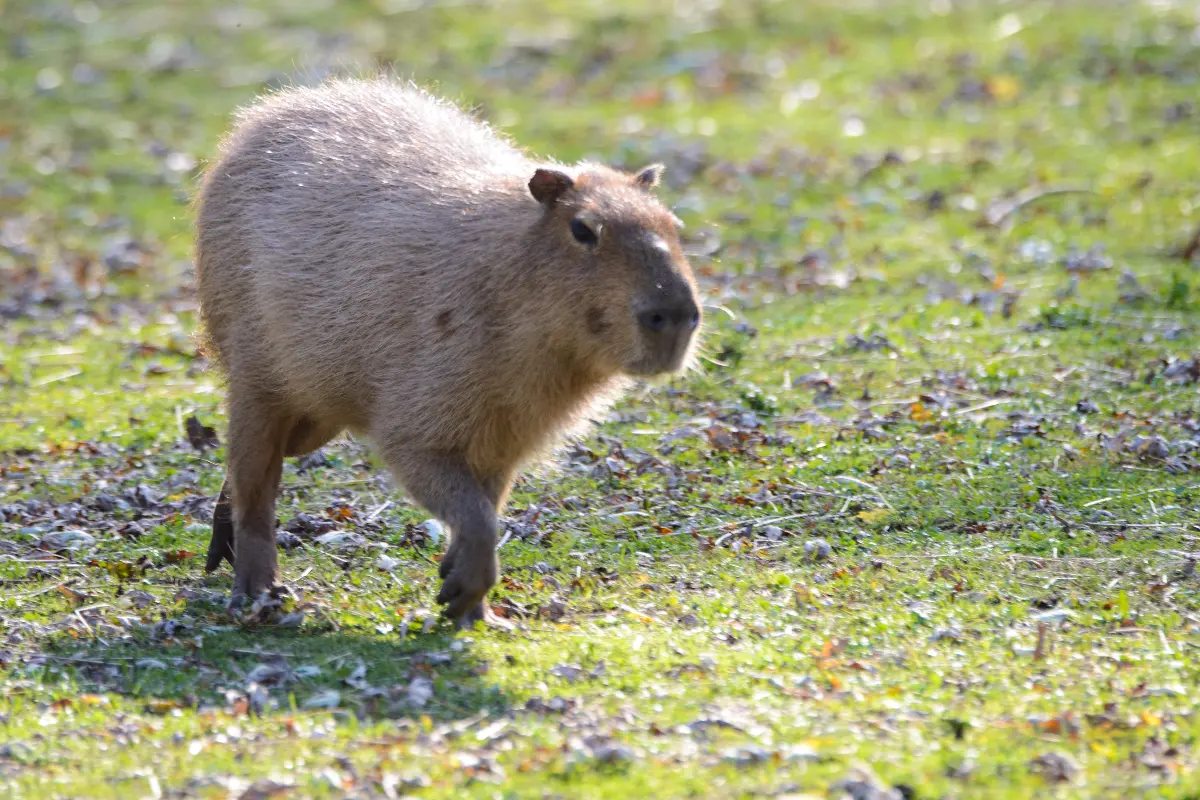Let us enter into the captivating, charming, and ever-curious world of the capybara – the lovable giant rodents that make their home in the lush landscapes of South America.
These comical creatures are both skilled swimmers and reasonably adept runners. Though they are more renowned for their aquatic abilities.
So today, we say “no” to the breakneck speed of cheetahs and the ballistic burst of falcons.
Instead, we’re going at a steady to answer the question swirling around in the minds of capybara enthusiasts globally: “Just how fast can a capybara run?”
We once wrote about Capybara Predators and you might want to have a read on it as it is also one of the running factors. It may not be the Indy 500 but fasten your seatbelts as you might be surprised as we explore their running capabilities.
Introduction to the Capybara
The capybara (Hydrochoerus hydrochaeris) is the world’s largest living rodent, reaching lengths of 100-140 cm (39-55 inches) and weighing between 35-65 kg (77-143 pounds). Possessing short limbs, a barrel-shaped body, and reddish-brown fur, capybaras have a unique appearance that has endeared them to wildlife enthusiasts around the globe.
Although their running prowess has been overshadowed by their exceptional swimming skills, it remains essential to their survival and way of life.
Exploring Their Natural Habitat
Capybaras inhabit various regions across South America, including Brazil, Colombia, Ecuador, and Peru. Preferring water-rich environments, such as wetlands, marshes, and riverbanks, their innate swimming abilities have earned them the nickname “water pigs.” As creatures that thrive in aquatic habitats, it may come as a surprise to learn of their respectable competence on land.
How Capybaras Compare in the Animal Kingdom
In the grand scheme of the animal kingdom, capybaras will not be winning any sprint championships. For context, the fastest land animal, the cheetah, achieves breathtaking speeds of up to 75 mph (120 km/h), while animals like pronghorns and ostriches can reach 55 mph (88 km/h) and 45 mph (72 km/h) respectively.
However, despite not breaking speed records, capybaras maintain their status as underestimated runners, often surprising those who underestimate their land-based abilities.
So How Fast Can a Capybara Run?
Although not built for speed, capybaras have evolved to become competent runners when needed. With top speeds ranging between 15-22 mph (24-35 km/h), capybaras leverage their sturdy limbs and powerful musculature to effectively traverse various terrains.
Due to their size and body structure, their running gait is characterized by smooth, bounding motions, which are more efficient for their particular anatomy.
Factors Affecting Capybara Running Speed
Several factors influence how fast a capybara can run, including:
- Age: Younger capybaras tend to run faster than their older counterparts.
- Health: A capybara’s physical conditioning plays a crucial role in its top speed.
- Terrain: Slippery, muddy, or uneven landscapes can negatively impact a capybara’s running performance.
- Motivation: The presence of a predator or pressing need can spur even faster speeds than usual.
Why Does Capybara Run? Running for Survival
Running is essential for capybaras for several reasons:
- Predator Evasion: Capybaras have multiple natural predators such as jaguars, ocelots, large snakes, and caimans. Their running abilities are crucial for evading these predators in times of danger.
- Foraging and Food: Capybaras are herbivores, consuming vast quantities of grasses, aquatic plants, and other vegetation. Their grazing habits can necessitate covering expansive areas to find ample food sources, at times requiring swift terrestrial navigation.
- Social Cohesion: As highly social creatures, capybaras live in groups called “herds,” sometimes consisting of up to 20 individuals. Running is essential to keep up with their cohorts and participate in integral group dynamics.
Human-made Challenges and Capybara Conservation
Capybaras face numerous human-made challenges, such as habitat destruction, poaching, and pollution. These challenges not only jeopardize their running and swimming potential but also threaten their overall survival as a species. Efforts to preserve capybara habitats and promote sustainable interactions with these gentle giants are crucial for their long-term well-being.
Our Final Thoughts
It’s clear that while capybaras may not be the fastest creatures in the animal kingdom, their size, body structure, and lifestyle have equipped them with a respectable range of running capabilities.
Running speeds of 15-22 mph (24-35 km/h) allow capybaras to evade predators, forage for food, and maintain intricate social hierarchies, all of which are essential to their lives and survival. While capybaras continue to charm us with their aquatic escapades, let us not forget their often-overlooked but equally indispensable running talents.
